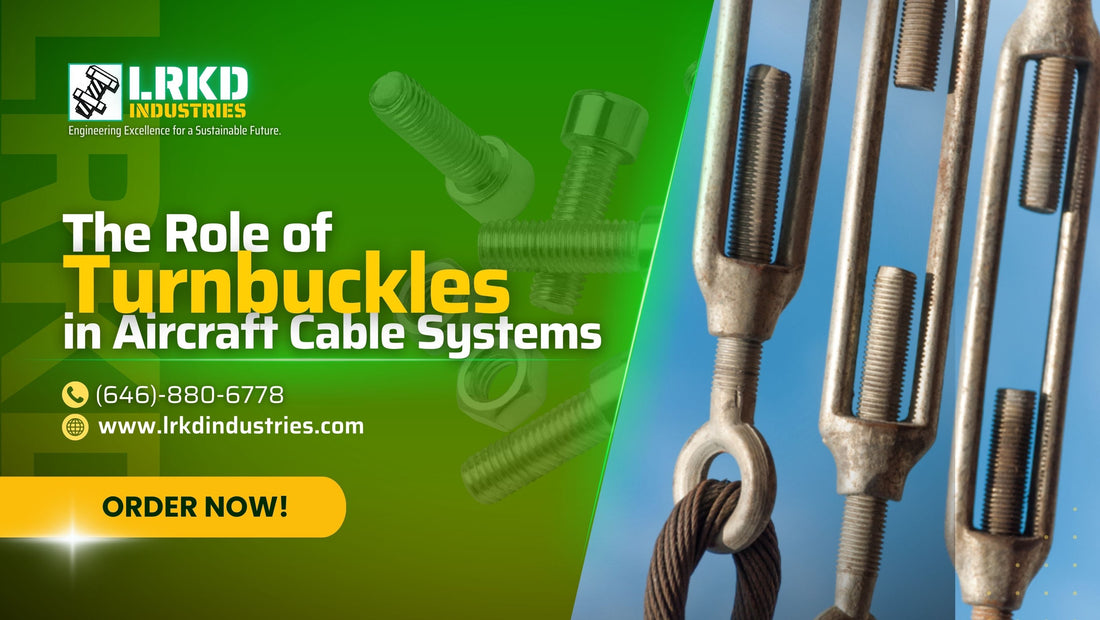When you look up and marvel at the intricate web of cables in a construction site or an aircraft hangar, have you ever wondered how they remain so taut and precise? Enter turnbuckles—the reliable components that silently ensure stability, safety, and compliance in critical systems. Whether you're an engineer, a construction worker, or someone fascinated by the intricate dance of mechanics, understanding turnbuckles is both enlightening and essential.
What Are Aircraft Cable Systems, and Why Do They Matter?
Imagine building a bridge, hoisting a load, or maintaining the structural integrity of an aircraft. Aircraft cable systems are the lifelines of these operations, designed to transfer loads, provide support, and ensure stability. These systems consist of strong steel cables used in a variety of industries, including aviation, construction, and even maritime setups.
However, cables alone cannot maintain the required tension over time. This is where turnbuckles come into play, acting as the adjusters that fine-tune the tension and alignment of these cables. Without them, safety setups could falter, leading to potentially disastrous outcomes.
Why Are Turnbuckles Critical?
Turnbuckles might be small, but they have a huge job to do. Here’s why they are indispensable:
Precise Tension Adjustment: Over time, cables can sag or lose their tautness due to environmental factors like temperature changes or prolonged use. Turnbuckles allow for easy adjustment, ensuring the system operates at peak performance.
Structural Integrity: In applications like bridges, aircraft, or cranes, even minor slack in cables can compromise stability. Turnbuckles help maintain the exact tension needed for these structures to function safely.
Safety Compliance: For industries governed by OSHA (Occupational Safety and Health Administration), maintaining tension in cable systems is a legal requirement. Improper tension can lead to safety violations, hefty fines, or worse, accidents.
How Do Turnbuckles Work?
Turnbuckles are mechanical devices consisting of a metal frame with threaded ends. These ends connect to eye bolts, hooks, or other fittings, which, in turn, attach to the cables. By turning the body of the turnbuckle, you either tighten or loosen the tension in the cable.
Here’s a relatable analogy: Think of turnbuckles as the laces on a well-worn pair of hiking boots. When the laces get loose, you tighten them for better support. Similarly, turnbuckles “lace up” cable systems, ensuring they are secure and reliable.
Turnbuckles in Action
Aircraft Hangers: In aviation, cables secured with turnbuckles are used to stabilize aircraft components and secure planes during maintenance. Properly tensioned cables ensure that nothing shifts unexpectedly, maintaining both safety and efficiency.
Suspension Bridges: Picture iconic suspension bridges like the Golden Gate. Turnbuckles play a key role in adjusting the tension of the cables that hold the bridge deck in place, ensuring it withstands varying loads and weather conditions.
Construction Sites: In temporary setups like scaffolding or tension structures, turnbuckles allow quick adjustments to keep everything stable, especially under dynamic loads like wind.
Tips for Using Turnbuckles Effectively
Choose the Right Material: For outdoor or corrosive environments, opt for stainless steel turnbuckles to prevent rust.
Inspect Regularly: Check turnbuckles for wear and tear, especially in high-stress applications.
Follow OSHA Guidelines: Ensure the system meets safety standards, including proper tension levels and secure fittings.
Use Safety Locks: To prevent accidental loosening, use lock nuts or safety wires on your turnbuckles.
The Role of OSHA Compliance
Did you know that OSHA requires regular inspections and maintenance of cable systems in industrial applications? Non-compliance isn’t just a regulatory issue; it’s a matter of life and death. Turnbuckles are key to meeting these standards because they allow you to maintain proper tension, reducing the risk of accidents caused by slack or frayed cables.
Consider the 2009 construction incident where an improperly tensioned cable snapped, causing a scaffold collapse. Such tragedies highlight the importance of using tools like turnbuckles to ensure both safety and compliance.
Small Tools, Big Impact
Turnbuckles may not be glamorous, but their role in stabilizing cables and ensuring safety is monumental. Whether you're overseeing a construction project, maintaining an aircraft, or simply curious about the mechanics behind safety systems, understanding turnbuckles is a lesson in precision and responsibility.
So next time you see a suspension bridge or an aircraft cable system, think about the turnbuckles quietly doing their job behind the scenes. Their story is a reminder that even the smallest components can make the biggest difference.
Ready to ensure your systems are stable and compliant? Start by giving your turnbuckles the attention they deserve.
Aircraft Cable Stabilization Solutions
Stabilizing aircraft cable systems just got easier. LRKD Industries offers expert material assessments and quantification for the turnbuckles needed in your aviation projects. Designed to support teams focused on safety, precision, and regulatory compliance, our service ensures each cable system component meets OSHA standards—without the manual calculations.
Whether you're prepping for a bid or managing an active job, we streamline the process to give you fast, accurate evaluations based on your project drawings.
Contact LRKD Industries now for this time-saving service!
👉 Submit your plans today for a FREE consultation and aircraft cable system evaluation.
📍 Address: 98 N Industry CT, Deer Park, NY 11729, US
📞 Phone: +1 646-880-6778
📧 Email: info@lrkdindustries.com
We can also convert your files into .dwg format for Tekla compatibility, supporting seamless integration with your digital modeling and fabrication systems.
For more information about our Aircraft Cable products, Click here!
When every connection matters, trust in OSHA-compliant accuracy.


